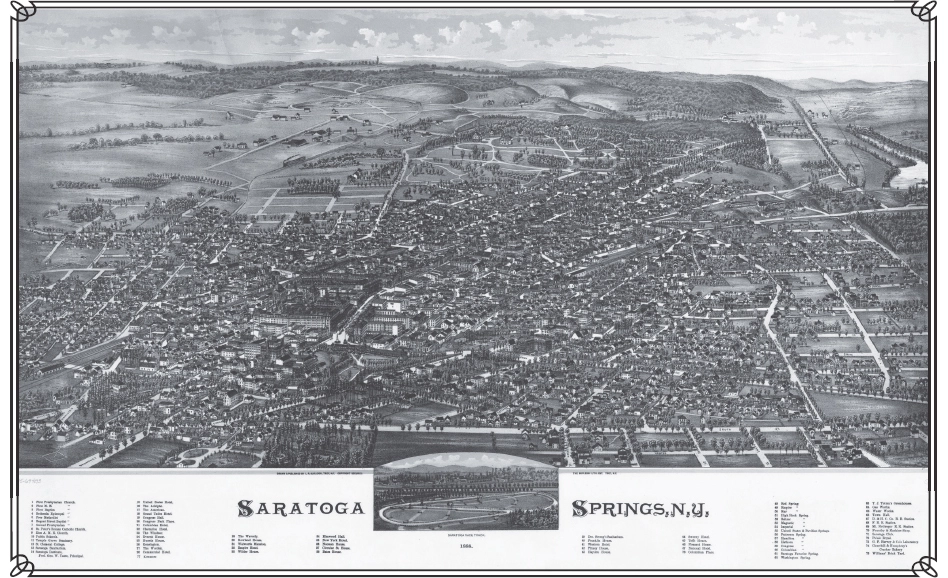De Forest, “The Great American Novel,” Nation 6 (January 9, 1868): 27–29.
i Henry James, Roderick Hudson, in Novels, 1871–1880 (New York: Library of America, 1983), 168.
j Henry James to Charles Eliot Norton, February 4, 1872, in Edel, Henry James Letters, 1:274.
SARATOGA
August 3, 1870

Map of Saratoga Springs, ca. 1888.
ONE HAS VAGUE IRRESPONSIBLE LOCAL PREVISIONS OF which it is generally hard to discern the origin. You find yourself thinking of an unknown, unseen place as thus rather than so. It assumes in your mind a certain shape, a certain color which frequently turns out to be singularly at variance with reality. For some reason or other, I had idly dreamed of Saratoga as buried in a sort of elegant wilderness of verdurous gloom. I fancied a region of shady forest drives, with a bright, broad-piazzaed hotel gleaming here and there against a background of mysterious groves and glades. I had made a cruelly small allowance for the stern vulgarities of life—for the shops and sidewalks and loafers, the complex machinery of a city of pleasure. The fault was so wholly my own that it is quite without bitterness that I proceed to affirm that the Saratoga of experience is sadly different from this. I confess, however, that it has always seemed to me that one’s visions, on the whole, gain more than they lose by realization. There is an essential indignity in indefiniteness: you cannot imagine the especial poignant interest of details and accidents. They give more to the imagination than they receive from it. I frankly admit, therefore, that I find here a decidedly more satisfactory sort of place than the all-too-primitive Elysium of my wanton fancy. It is indeed, as I say, immensely different. There is a vast number of brick—nay, of asphalte—sidewalks, a great many shops, and a magnificent array of loafers. But what indeed are you to do at Saratoga—the morning draught having been achieved—unless you loaf? “Que faire en un gîte à moins que l’on ne songe?” Loafers being assumed, of course shops and sidewalks follow. The main avenue of Saratoga is in fact bravely entitled Broadway. The untravelled reader may form a very accurate idea of it by recalling as distinctly as possible, not indeed the splendors of that famous thoroughfare, but the secondary charms of the Sixth Avenue. The place has what the French would call the “accent” of the Sixth Avenue. Its two main features are the two monster hotels which stand facing each other along a goodly portion of its course. One, I believe, is considered much better than the other—less prodigious and promiscuous and tumultuous, but in appearance there is little choice between them. Both are immense brick structures, directly on the crowded, noisy street, with vast covered piazzas running along the façade, supported by great iron posts. The piazza of the Union Hotel, I have been repeatedly informed, is the largest “in the world.” There are a number of objects in Saratoga, by the way, which in their respective kinds are the finest in the world. One of these is Mr. John Morrissey’s casino. I bowed my head submissively to this statement, but privately I thought of the blue Mediterranean, and the little white promontory of Monaco, and the silver-gray verdure of olives, and the view across the outer sea toward the bosky cliffs of Italy. Congress Spring, too, it is well known, is the most delicious mineral spring in the known universe; this I am perfectly willing to maintain.
The piazzas of these great hotels may very well be the greatest of all piazzas. They are not picturesque, but they doubtless serve their purpose—that of affording sitting-space in the open air to an immense number of persons. They are, of course, quite the best places to observe the Saratoga world. In the evening, when the “boarders” have all come forth and seated themselves in groups, or have begun to stroll in (not always, I regret to say, to the sad detriment of the dramatic interest, bisexual) couples, the vast heterogeneous scene affords a great deal of entertainment.
1 comment